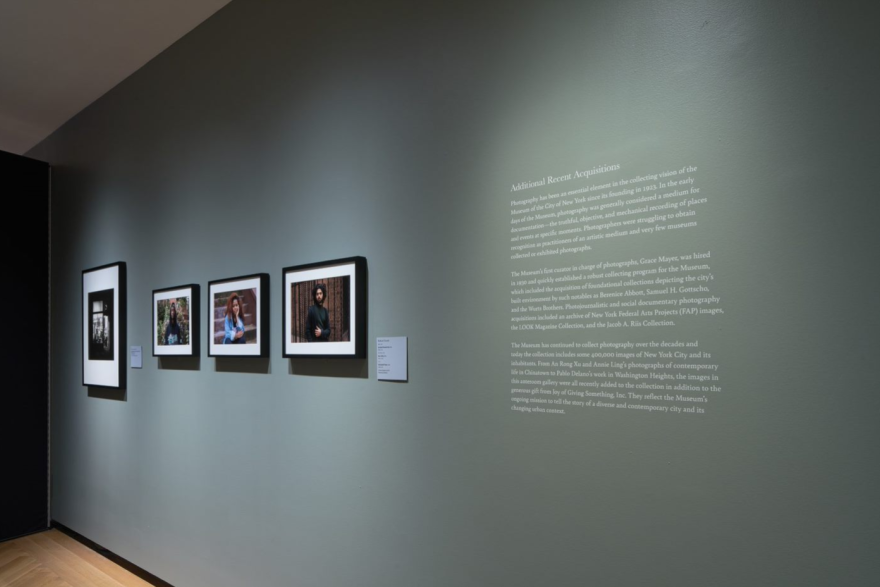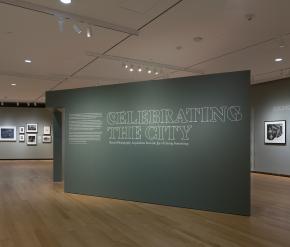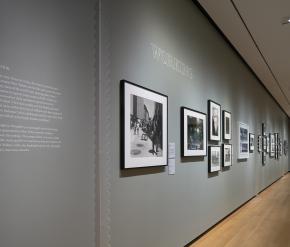Additional Recent Acquisitions

Photography has been an essential element in the collecting vision of the Museum of the City of New York since its founding in 1923. In the early days of the Museum, photography was generally considered a medium for documentation—the truthful, objective, and mechanical recording of places and events at specific moments. Photographers were struggling to obtain recognition as practitioners of an artistic medium and very few museums collected or exhibited photographs.
The Museum’s first curator in charge of photographs, Grace Mayer, was hired in 1930 and quickly established a robust collecting program for the Museum, which included the acquisition of foundational collections depicting the city’s built environment by such notables as Berenice Abbott, Samuel H. Gottscho, and the Wurts Brothers. Photojournalistic and social documentary photography acquisitions included an archive of New York Federal Arts Projects (FAP) images, the LOOK Magazine Collection, and the Jacob A. Riis Collection.
The Museum has continued to collect photography over the decades and today the collection includes some 400,000 images of New York City and its inhabitants. From An Rong Xu and Annie Ling’s photographs of contemporary life in Chinatown to Pablo Delano’s work in Washington Heights, the images in this anteroom gallery were all recently added to the collection in addition to the generous gift from Joy of Giving Something, Inc. They reflect the Museum’s ongoing mission to tell the story of a diverse and contemporary city and its changing urban context.
Bruce Cratsley
Brooklyn Bridge Centennial, 1983
Gift of the Joy of Giving Something Foundation, Inc., 2020.10.51. Reproduction courtesy of the Estate of Bruce Cratsley (www.brucecratsley.com), represented by Gallery Kayafas, Boston, MA.
Jeffrey Henson Scales
Nightfall [From the series “House’s Barber Shop, Harlem”], 1986–1992
Gelatin silver print
Gift of the photographer, 2019.46.2
Mahtab Hussain
Abdoulie Ibrahim Faal, New York, 2021
Archival pigment print
Museum purchase, 2022.1.1.4
My dad’s side of the family is from Senegal and Gambia, and my mom is French and Gambian. I grew up practicing, but I’m not orthodox. There are times when I’m out with friends and get a pepperoni pizza or a bacon, egg, and cheese sandwich from the bagel spot. But Islamic concepts, such as peace, hospitality, and charity, are all deeply ingrained in me from my upbringing; not just the religion, but what and who we are, and the values Islam exemplifies that we take wherever we go.
One of my earliest memories in the airport was when I was six, travelling back to the US after going to Papua New Guinea for Christmas. I was profusely checked, more than anyone else. Afterwards, my parents said ‘Oh, Abdoulie we have to talk about what your name means at the airport. There was this thing called 9/11 that happened in 2001, and your name is prominently Muslim. People are going to be afraid of you because of what others did, but don’t take that to heart—you’re not who they think you are.’ But now with social media, and the rise of Gen Z, and demands for change, there’s a wider representation of Muslim experience. It’s really good to see. — Abdoulie Ibrahim Faal
Mahtab Hussain
Bree Darby, New York, 2021
Archival pigment print
Museum purchase, 2022.1.1.10
I was born in New York and have been here all my life. My dad—who is not religious—is Black, from South Carolina, and my mom is from Hyderabad, India. My relationship with Islam is a little complicated, because I grew up with all these toxic ideas of sexuality, and how women should be treated in our community that my mom taught me. Throughout my childhood, I thought I would graduate with a medical degree, get married at 22, and otherwise not interact with any guys; be like a pure, good girl. It wasn’t until I got to college, I realized that wasn’t the life that I wanted. Even recently, I visited an aunt’s house in Staten Island where she told all the women in our family how we can’t just interact with any guy we like, and that if we do, we will be tainted and go to hell. I made a face that showed disgust. She pulled me aside, telling me she did not appreciate that attitude.
Sometimes I feel trapped. As an adult, I have had to figure out how to unlearn much of what I was taught; how I can practice Islam differently, despite my family’s views. It took time to learn that everyone’s relationship with Islam is unique, and to find my own place in it. — Bree Darby
Mahtab Hussain
Yasser Mohammad, New York, 2021
Archival pigment print
Museum purchase, 2022.1.1.12
Growing up in Abu Dhabi was an interesting experience. It’s a Muslim country, so you see Muslims and mosques everywhere, but it’s difficult to find community. Yes, there is a community at the mosque, but I struggled to find it elsewhere, or to meet new people on the basis of my faith. Coming to New York, the most striking difference is how much easier I found it to meet people and strike up conversation. It’s funny; people talk about the individualism of the West, and the stereotype of New York is that people are rude and do their own thing, but here, you quickly get beyond small talk. You can get talking to anyone.
A big aspect of Islam is to spread the message and the faith, but over time I think this is something Muslims have given up on. Part of that is about people going their own way and focusing too much on themselves. But I think this has contributed to a lack of awareness of Islam, which in turn has allowed Islam to be misinterpreted by others. I think there is a conscious effort amongst Muslims to not really talk about Islam. Often you are in that awkward situation with other Muslims where you see that they are doing something wrong but you don’t want to mention it to them. We recognize that everyone is on their own journey, but we may have lost the balance between not judging others, and doing good by informing them. — Yasser Mohammad
Pablo Delano
Merengue Musicians, Upper Broadway, 1994–1995
2021.15.14
Dancers at Dominican Day Parade, Midtown, 1994–1995
2021.15.15
Gelatin silver prints
Gifts of the photographer
Pablo Delano was born in 1954 in Puerto Rico. He moved to the East Coast to study art, first at Temple University then, later, Yale University. In 1980, he came to New York to teach art at an after-school program on the Lower East Side and began documenting life in the city. These two photographs, one of a merengue band performing on the sidewalk in Washington Heights and another of dancers at the Dominican Day Parade, were commissioned by the New York City School Construction Authority and the New York City Department of Cultural Affairs under the Percent for Art Program in 1995. The work was installed at
P.S. 4 on 160th and Amsterdam Avenue (The Duke Ellington School.).
An Rong Xu
Grand Park Girls, 2011
Archival pigment print
Museum purchase, 2019.38.1
Jamel Shabazz
Untitled [Two women in blue posed in the subway], 1979 (printed later)
2020.17.19
Untitled [Four men posed in front of hat display], 1982 (printed later)
2020.17.16
Chromogenic development prints
Gifts of the Martin Z. Margulies Foundation
Leee Black Childers
Jackie Curtis in Times Square, 1969 (printed later)
Archival pigment print
Museum purchase, 2020.3.1
Lee Black Childers was born in Kentucky and later added an extra “e” to his first name simply to draw attention to himself. Childers moved to New York in the late 1960s and became intimately associated with Andy Warhol’s Factory and New York’s avant-garde theater milieu. He spent much of the 1960s and 1970s as a stage and music manager and photographed celebrities, including David Bowie, Lou Reed, and Blondie’s Debbie Harry. In the early 1970s, Childers was stage manager at the off-Broadway venue La MaMa Theatre, working on such productions as Jackie Curtis’s play Femme Fatale. In 1971, he was stage manager of Warhol’s Pork when it transferred from La MaMa to London’s Roundhouse.
Performer Jackie Curtis, pictured here, was an integral part of the Warhol Factory scene and an important figure in avant-garde theater. She debuted at the age of 17 in Tom Eyen’s play Miss Nefertiti Regrets, produced in 1965 at La MaMa Theatre, and went on to perform both male and female roles throughout her career. Andy Warhol and director Paul Morrissey cast Curtis in Flesh (1968) and in Women in Revolt (1971), a comedic spoof of the women’s liberation movement. Curtis died of a heroin overdose in 1985.
Jill Freedman
Double Trouble, 1983
2021.24.1
Fire and Ice, 1972
2021.24.2
Gelatin silver prints
Gifts of the Estate of Jill Freedman
Jaime Permuth
Untitled [From the series “Yonkeros”], 2010
2021.16.3
Untitled [From the series “Yonkeros”], 2010
2021.16.2
Archival pigment prints
Museum purchases
Jamie Permuth was born in Guatemala and moved to New York City to attend the School of Visual Arts. Here, Permuth photographed the Hasidic communities of Brooklyn. The photographs on view here are from Permuth’s series, “Yonkeros,” which chronicled life in Willets Point, Queens, a neighborhood nestled next to the Mets’ Citi Field that was then known as the “Iron Triangle” for its once-thriving community of auto mechanics. In Permuth’s words, his photographs were intended to be “a lyrical exploration of First World consumerism, waste, and obsolescence as they intersect with Third World ingenuity and survivalist strategies in the no-man’s land of Willets Point.” The last auto shop in Willett’s Point was shuttered in 2016 to make room for a massive planned redevelopment.
Máximo Colón
El Niño y su Camisa Blanca Fiesta de Loiza (Boy in white shirt, Loisaida, Avenue C), 1975 (printed later)
Gelatin silver print
Museum purchase, 2021.6.3
Annie Ling
81 Bowery, Residents Cool Off on the Fire Escape on a Hot Summer Evening, 2011
Archival pigment print
Museum purchase, 2020.12.14
Continue exploring the exhibition
Celebrating the City: Online
Return to the online exhibition overview
Celebrating the City: Main Gallery
Explore Main Gallery Content



